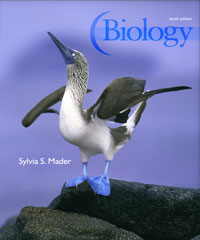Biology (Mader), 10th EditionChapter 20:
Viruses, Bacteria, and ArchaeaLearning OutcomesAfter studying this chapter, you should be able to accomplish the following outcomes.
Viruses, Viroids, and Prions
- List the major components of a virus.
- List the three criteria used to categorize viruses.
- Explain why viruses are considered to be obligate intracellular parasites.
- Outline the steps of bacteriophage reproduction, distinguishing between lytic and lysogenic cycles.
- Outline the steps of animal virus reproduction, explaining how the process differs from that in bacterial cells.
- Explain why retroviruses are unique.
- Provide examples of human diseases that are caused by viruses, particularly emerging viruses.
- Compare and contrast viroids and prions with one another and with viruses.
The Prokaryotes- Describe the structure of a typical prokaryotic cell.
- Explain how prokaryotic cells reproduce.
- List the three means of genetic recombination in prokaryotes.
The Bacteria- List the defining characteristics of members of domain Bacteria.
- Describe how bacteria may be categorized with respect to their oxygen needs and tolerances.
- Describe the nutritional modes of photoautotrophic, chemoautotrophic, and chemoheterotrophic bacteria.
- Provide examples of symbiotic relationships between bacteria and other organisms.
- Provide examples of human diseases caused by bacteria.
- Explain how bacterial endospores enable survival in harsh conditions.
- Explain how antibiotic drugs harm bacteria.
- Discuss the ecological significance of cyanobacteria.
The Archaea- State the unique characteristics of domain Archaea that led to them being classified separately from the members of domain Bacteria.
- List the three categories of archaea based on the extreme habitats in which they are found.
Health Focus: Flu Pandemic- Explain why the HN51 virus is of so much concern.
- List steps that can be taken to prepare for pandemic flu.
 | 




